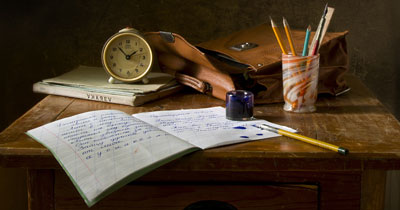 When you write about your art you leave the world of images and enter the world of words. Going from the visual to the verbal plane is a profound shift in perspective. When you try to write about your art, something happens. You procrastinate because it feels awkward. You fear that words will destroy the fragile integrity of your work, or reduce it to something less than it is. Try to remember that making art and writing about it are profoundly different ways of communicating what you know. One does not replace or destroy the other. When you write well about your art, you open a door to all the people who live in the world of words. Writing, like art-making, is a creative process that you can learn. The process develops in stages, where one stage leads to the next.
Create good conditions Pay special attention to your setting, materials and process. Find an appealing place to write. It might be a corner in your apartment or a table at your favorite café. Choose a place that you like to be. Then think about writing materials. If your brain shuts down when your fingers hit the keyboard, consider using an old-fashioned pen and notebook or a stick of charcoal and a sketchbook. These implements create a physical connection between your hand and your brain. Make your writing process portable. Even if you start at a keyboard, always have writing materials with you. Discover what you want to say To begin, don’t stare at a blank screen or empty notebook. Look at your art. First, look through your bodies of work. Review images as well as actual works, and think about what they have in common. Write down a few words or phrases that capture your intentions. Then pay attention to individual works of art. Choose one or two of your favorites, and notice the details. How do they convey meaning? You might note your use of color or composition or choice of materials. Again, write down a few details that are worth noting. Create that messy first draft Your goal is to write a page or less about your art. Think of it as a new artist statement, written in the first person. Your page will be messy and long because you won’t find the right words until you write down a lot of almost-right ones. Work for an hour or so, and then stop. Put your writing aside. Take a walk or do something else that keeps you in motion. Your brain will keep working, searching for better words. This is why you have a mobile writing process, so you can easily keep track of new thoughts as they occur. Revise, edit, and polish When you have a first draft that makes sense to you, print it. Your words look different on the screen vs. the printed page. Revise again. Editing at this stage is a pruning process, where you cut off the dead parts to help the living plant grow. Now you can ask for feedback from friends and professionals. Ask them to tell you if your ideas are clear, or if there are awkward or confusing places. Incorporate useful suggestions. You learn to write by writing, just as you learn to play the violin by playing it. Honor the stages of this creative process, and you’ll gradually become a better writer. * Please note: I recently published a longer version of this article in the October 2019 Newsletter for www.callforentries.com. This is a well-curated national site which lists open calls for artists and photographers. Please take a look, artists can join for free! ~ Mary Mary Edwards, Ph.D Career & Life Coach for Artists “Left Brain Skills for Right Brained People” Instagram: coachingforartists.maryedwards Comments are closed.
|
Mary's BlogAs an artist coach, I bring a unique combination of business knowledge, art world experience, and professional coaching skill to my practice. |